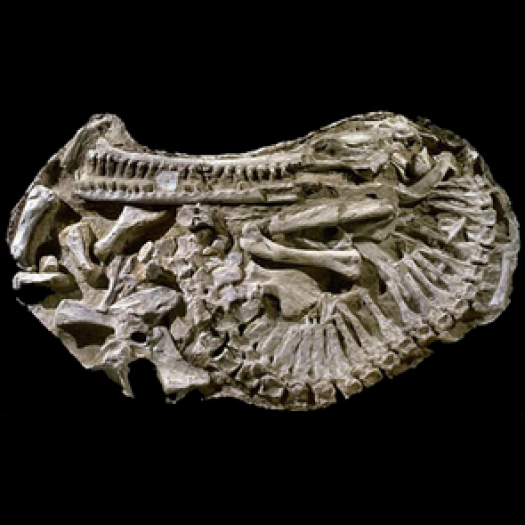Fossil vertebrates from the phosphate Basins of Morocco


The study of fossil vertebrates from the phosphate Basins of Morocco (Late Cretaceous – Early Eocene) is the subject of a collaborative scientific program between the National Museum of Natural History of Paris (MNHN, UMR 7207 of the CNRS – Department of Origin and Evolution), the Ministry of Energy, Mines, Water and Environment (MEMEE, Rabat), the Cherifian Phosphate Office (OCP, Casablanca), the Cadi Ayyad University (UCAM, Marrakech), the University Hassan II of Casablanca (Faculté des Sciences Ben M'Sik, Casablanca), as well the University of the Basque country (UPV/EHU, Bilbao).

The outstanding feature of the fossiliferous phosphate basins known in Morocco is the exceptional paleobiodiversity preserved locally during 24 Myr, from the Late Cretaceous to the Early/Middle Eocene. The Moroccan phosphate basins provide original data on the in situ evolution of marine and terrestrial faunas especially during the K/T and P/E major events in poorly known palaeobiogeographical provinces (South Atlantic, Southern Tethys margin, Africa).
The primary aim of the project is a palaeontological study by a multidisciplinary team of the exceptional local vertebrate faunas, especially those from the Ouled Abdoun and Ganntour basins, with research lines such as systematics, phylogeny, biostratigraphy, faunal evolution and turnover (especially during K/T and P/E transitions), palaeobiogeography and palaeoecology.
Coupled with the palaeontological research program, the project plans to gather and manage an international reference collection representative of the palaeobiodiversity of the vertebrate faunas from the phosphates basins of Morocco, relevant to research, education and exhibition. This collection, which constitutes a world-wide natural heritage of Morocco, is the basis for of a palaeontological museum project by the OCP in the mining center of Khouribga, with the support of the Department of the Galeries of the NMNH.
| Tel: |
(33) 1 40 79 34 55
|
(33) 1 40 79 30 20 |
(33) 1 40 79 34 69 |
| Fax: |
(33) 1 40 79 35 80
|
(33) 1 40 79 35 80 |
(33) 1 40 79 35 80 |
| e-mail: | |||
|
“Center for Research on Palaeobiodiversity and Palaeoenvironments (CR2P) " Department « Origin and Evolution » National Museum of Natural History CP 38 8, rue Buffon 75231 PARIS cedex 05 France |
|||
The pioneer palaeontological work of Arambourg (1952) revealed and popularized the extraordinary fossiliferous richness of the Moroccan phosphate basins. Even focused on selachian systematical studies for biostratigraphic purposes this study has shown that the phosphates fossils constitute the worldwide richest vertebrate marine fauna spanning the K/T boundary. Since this extensive Arambourg's monography, these fossiliferous sites curiously remained poorly explored and studied for decads, especially concerning the tetrapod faunas. Succeeding researches began in 1980's and also focused on selachians, with the works of H. Cappetta (USTL, Montpellier) and A. Noubhani (UCDJ, El Jadida) (e.g. Noubhani & Cappetta, 1997).
The unexpected discovery of the oldest known proboscidean Phosphatherium (Gheerbrant et al., 1996) in the Ouled Abdoun Basin renewed the interest of these fossiliferous sites.
It was indeed the first occurrence of continental vertebrates in these marine deposits. Nearly 60 years after Arambourg's first works (1934-1937), this exceptional discovery revived palaeontological researches in the phosphate basins of Morocco with the collaboration of the OCP. It allowed the opportunity to develop an official French-Moroccan paleontological research program in collaboration with several researchers from the MNHN, UCAM, UCDJ, and other Institutions (USTL Montpellier, UPV/EHU Bilbao).
Several French-Moroccan fieldwork campaigns have been developed between 1997 and 2010 in the Ouled Abdoun and Ganntour phosphate basins, resulting in important paleontological discoveries - especially for tetrapod taxa. They significantly improve our knowledge of local vertebrate faunas since C. Arambourg’s work.
Our team reported especially:
Fossils discovered in the phosphate basins of Morocco, and especially those of the Ouled Abdoun Basin, were the subject of two MNHN PhD theses, by S. Jouve (2004) on crocodilians, and E. Bourdon (2006) on birds. It was also part of the Habilitation theses of E. Gheerbrant (2001) and N. Bardet (2004).
Besides systematic and phylogenetic studies, works in progress focuse on:
Arambourg C. (1935). Note préliminaire sur les vertébrés fossiles des phosphates du Maroc. Bulletin de la Société Géologique de France, 5: 413-439, 2 fig., 2 pl.
Arambourg C. (1952). Les vertébrés fossiles des gisements de phosphates (Maroc-Algérie-Tunisie). Notes et Mémoires du Service Géologique du Maroc (Rabat), 92: 1-372.
Bardet (2004), Bardet et al. (2004a et b, 2005a et b) : see publications list of the team.
Bourdon (2005), Bourdon et al. (2005 a et b) : see publications list of the team.
Cavin et al. (2000) : see publications list of the team.
El Houssaini Darif (2007): see publications list of the team.
Gheerbrant (2001, 2009, 2010), Gheerbrant et al. (1996, 1998, 2001, 2002, 2003, 2005, 2006, 2012, 2014, 2016) : see publications list of the team.
Hua & Jouve (2004) : see publications list of the team.
Jouve (2004, 2005), Jouve et al. (2005a et b) : see publications list of the team.
Khalloufi B, El Houssaini-Darif K, Jourani E, Khaldoune F, Jalil NEN (submitted): see publications of the team.
Lucas J and Prévôt-Lucas L. (1996). Tethyan phosphates and bioproductites. In: Nairn AEM et al., eds.The Ocean Basins and Margins, The Tethys Ocean. New-York: Plenum Press, 8: 367-391.
Noubhani A, Cappetta H. (1997) : see publications list of the team.
Office Chérifien des Phosphates (1989). The phosphates basins of Morocco. In: Notholt AJG, Sheldon RP, Davidson DF, eds. Phosphates deposits of the world, Phosphate rock resources. Cambridge: Cambridge University Press, 2: 301-311.
Pereda Suberbiola et al. (2003, 2004) : see publications list of the team.
Solé et al. (2009) : see publications list of the team.


